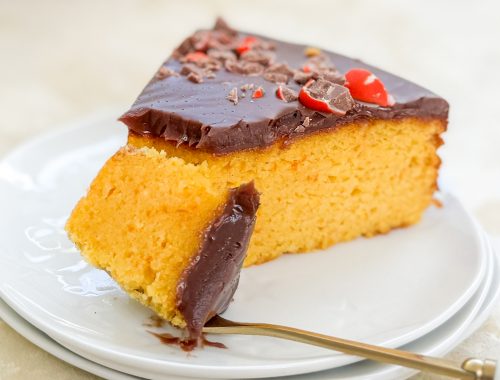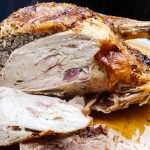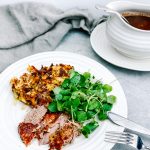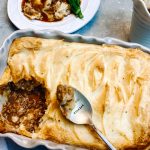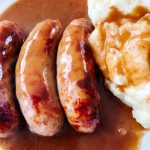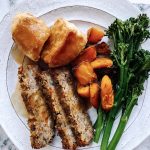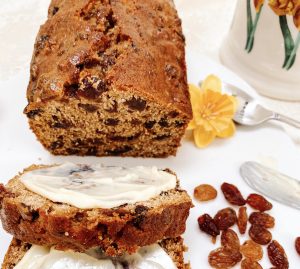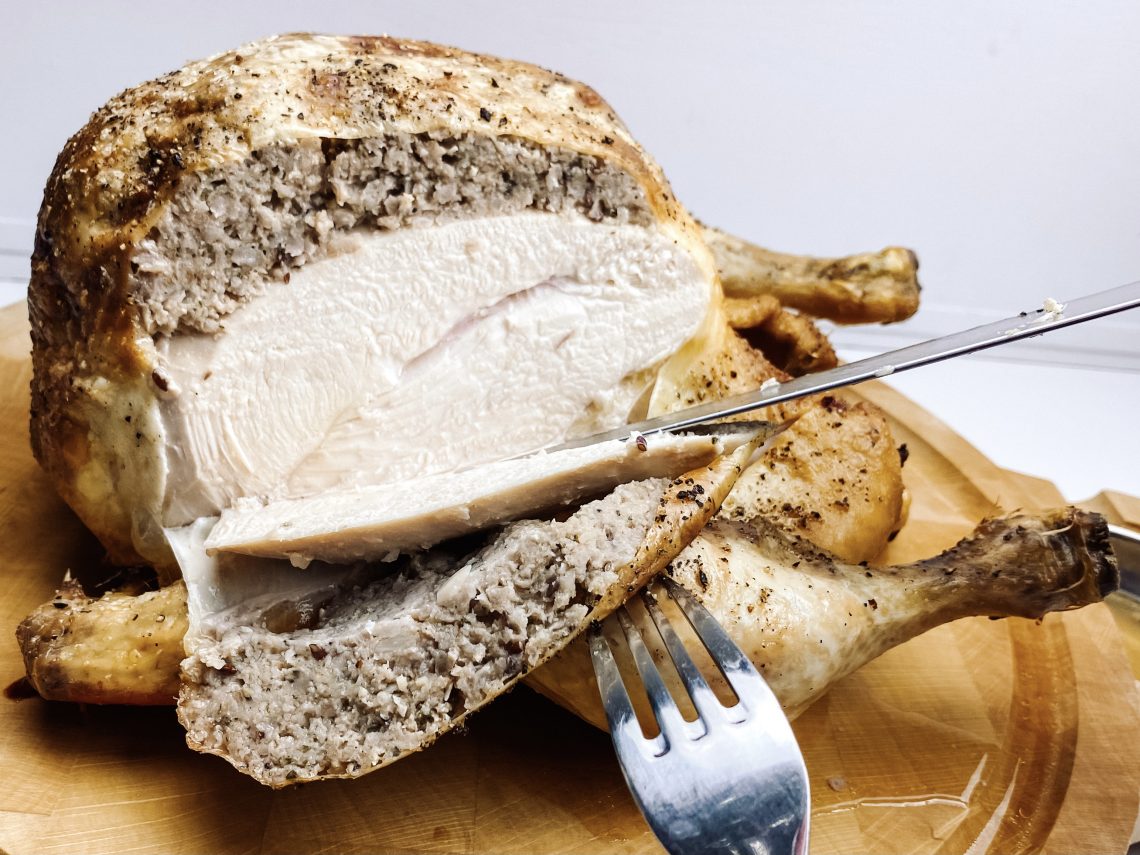
How I Roast Chicken for a Roast Chicken Dinner
Succulent and tender chicken meat cooked with and surrounded by a delicious layer of Sage, Onion and Sausagemeat Stuffing. The chicken is infused with the flavours from the stuffing, whilst at the same time, it bastes the chicken with extra fat ensuring the meat is moist and tender, even though it may have been cooking for a couple of hours.
I already have quite a few different roast chicken recipes on this site, but this is how I always do my chicken for a traditional roast dinner. You know, when the weather outside is blowing a gale, the rain is lashing down and you are seeking complete comfort on your plate and a lazy afternoon cuddled up on the sofa watching a good film with a full tummy and the rest of a fabulous bottle of wine.
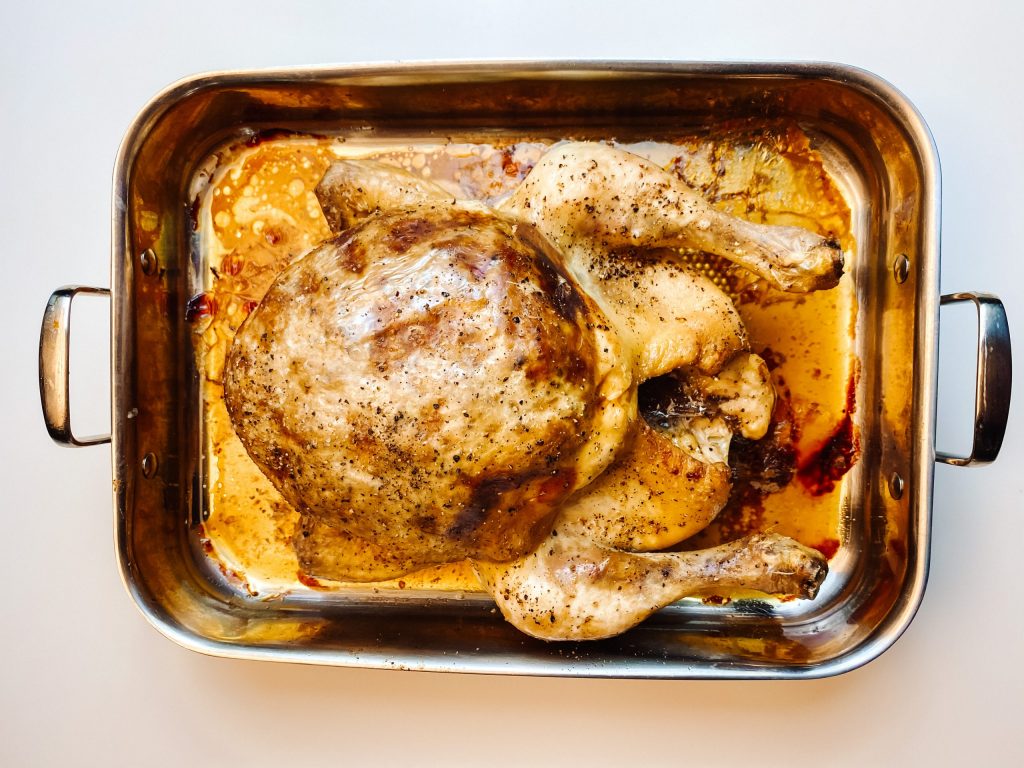
When you want soft, tender roast chicken, crispy roast potatoes, creamy, dreamy mashed potatoes, roast vegetables and some green vegetables all smothered in lashings of gravy. Emma and I love some stewed apple on the side with our roast – (chicken for me and nut roast for Emma) but Andrew and Charlotte think we are very strange and really would not!
This should most definitely be followed by some sweet comfort, although possibly a few hours later! My go to would be a hot, fresh Blackberry and Apple Crumble (any crumble in fact!) or indeed any fruit pies, with lashings of custard, cream or ice cream, whichever you prefer, or all three. To complete the picture, I think I would also have to include a little nap, most probably on the sofa, and usually and very frustratingly in the middle of the film!
I digress. Back to that chicken which started all this dreaming!
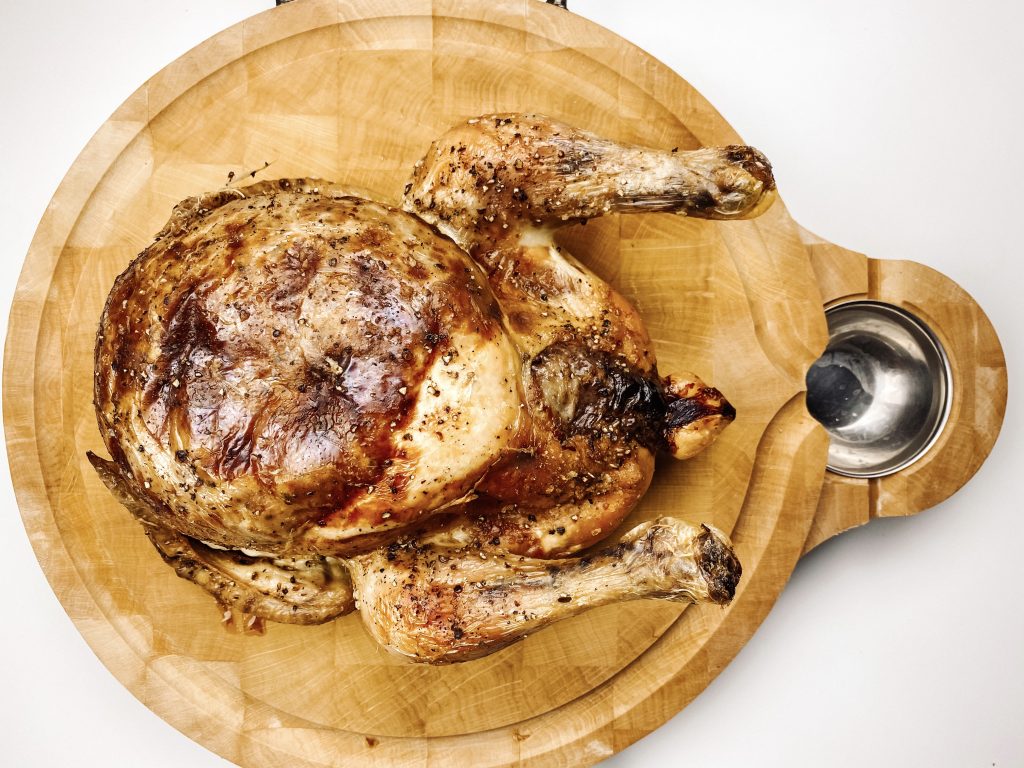
How to make Roast Chicken for a Roast Chicken Dinner
Collect all your ingredients together:
- 1 whole chicken, roughly 2 – 2.5kg in weight
- 1 quantity of Sage and Onion Sausagemeat Stuffing
- olive oil
- sea salt
- freshly ground black pepper
First of all, make the Sage and Onion Sausagemeat Stuffing:
Please see here for full recipe but in short, you need to blend together bread, onion, sage, sausagemeat and seasoning in a food processor. Quick, simple and so worth it!
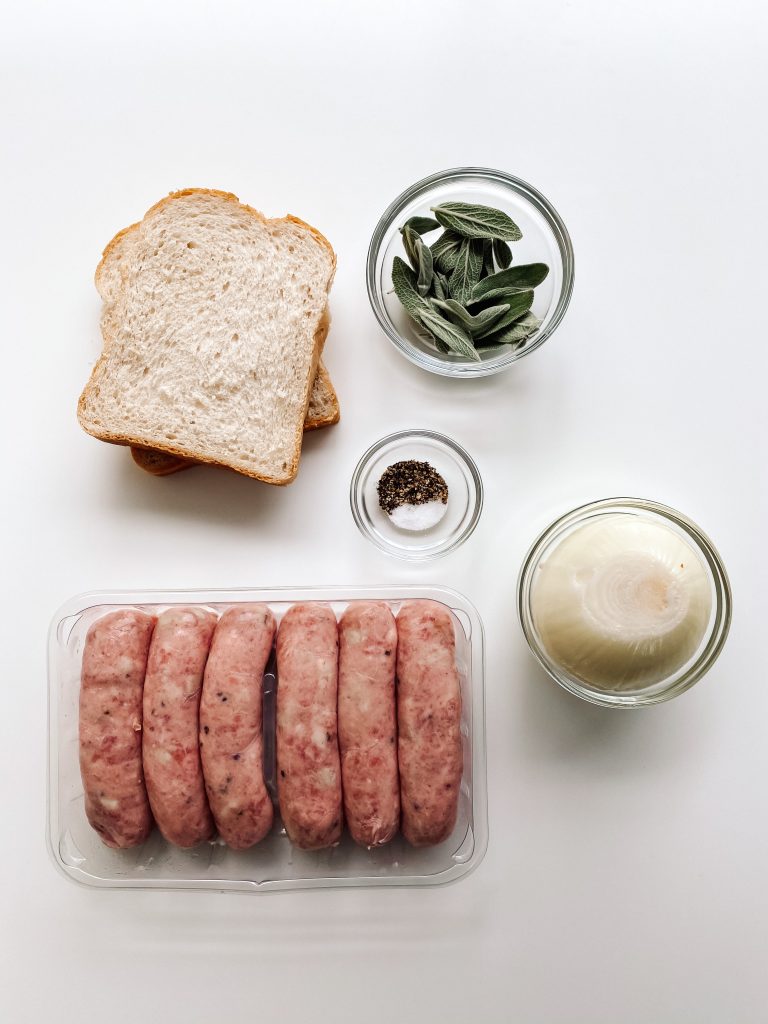
Ingredients 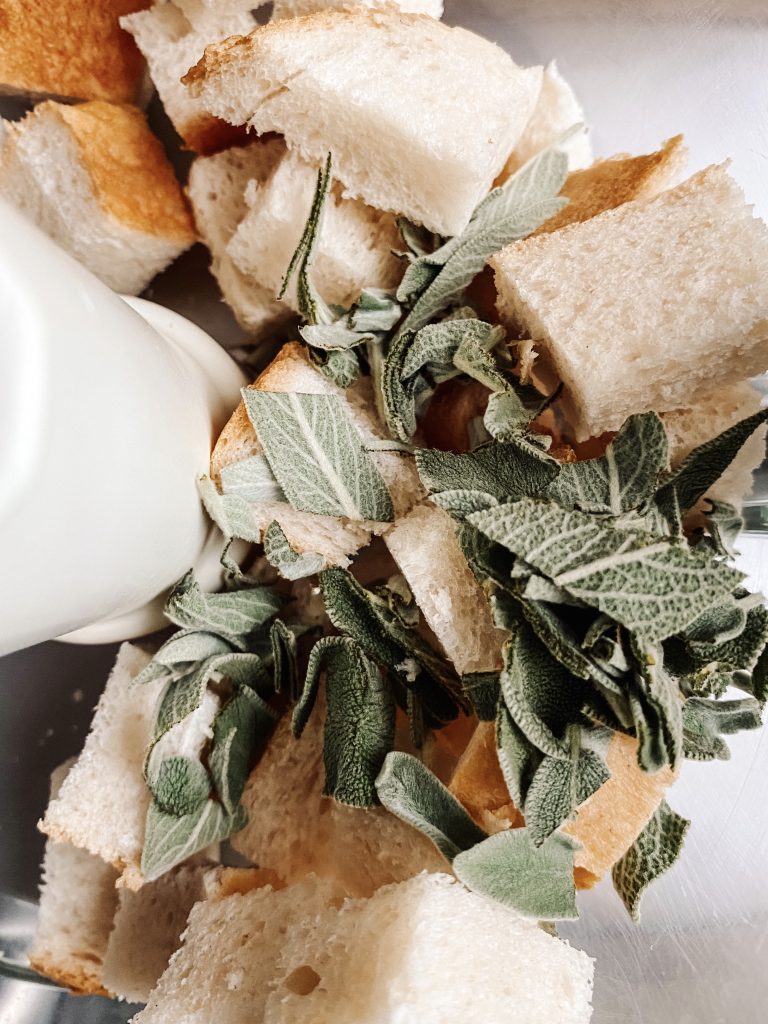
Bread and sage 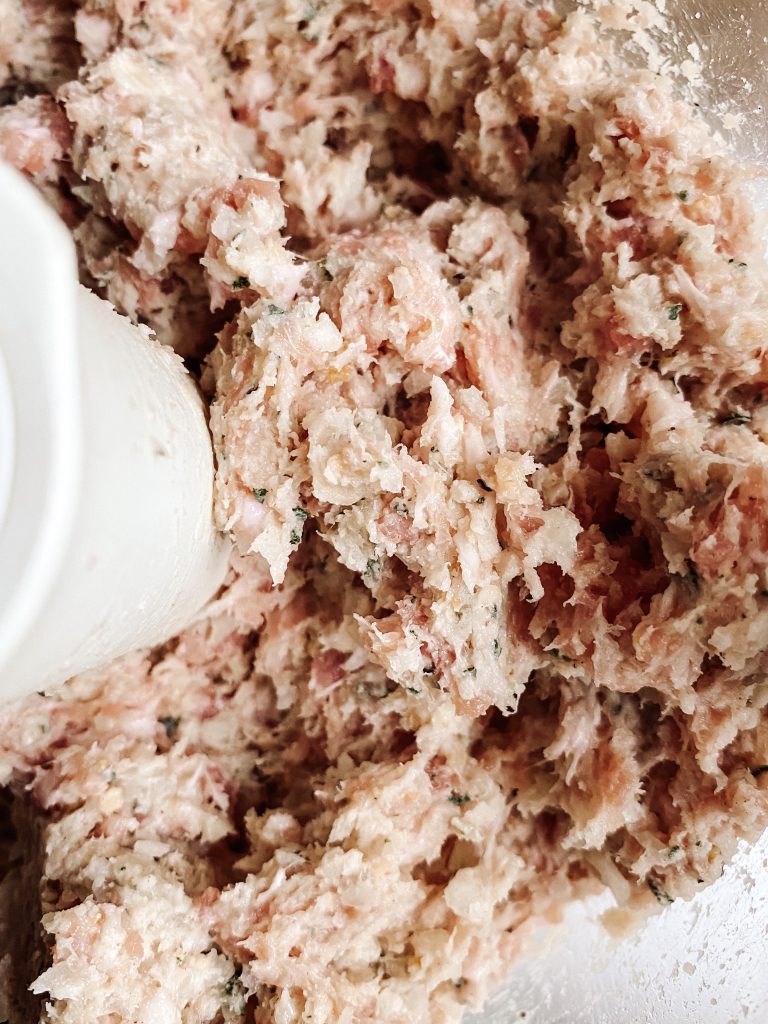
Finished stuffing
Stuff the Chicken:
We like a lot of stuffing in our chicken. If you are using a smaller chicken, you will definitely need less stuffing. If I buy a little chicken just for Andrew and me, say 1.4kg – 1.5kg, I would use half the stuffing. It freezes well, so I would make the whole amount and freeze the other half for another occasion.
- I like to put a layer of stuffing between the skin of the chicken and the breast meat. To do this, use your hand to gently ease the skin from the meat and make space for the stuffing. You can use a spoon to do this but I have ripped the skin by mistake too many times, so I always use just my hand instead.
- Stuff the area between the skin and the breast meat with around 1/3 of the stuffing. Gently ease it into the space using your hand, being careful not to rip the skin
- Use your hands to pat the stuffing into a neat shape and to ensure it is roughly the same thickness over the breast.
- Put the remaining stuffing inside the cavity of the chicken
(NB Should you be using a stuffing which does not contain the sausagemeat, do not put a layer between the skin and the breast meat. You may find it dries out your meat rather than basting it with extra flavours and fats.)
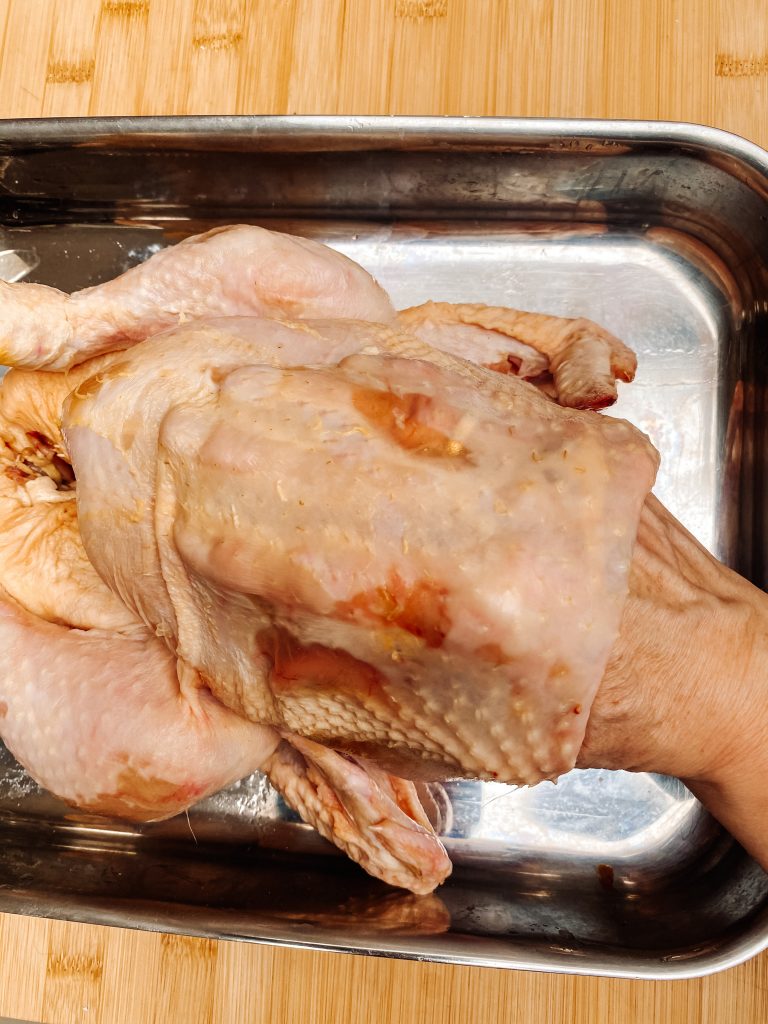
1 Use your hand to ease the skin from the breast 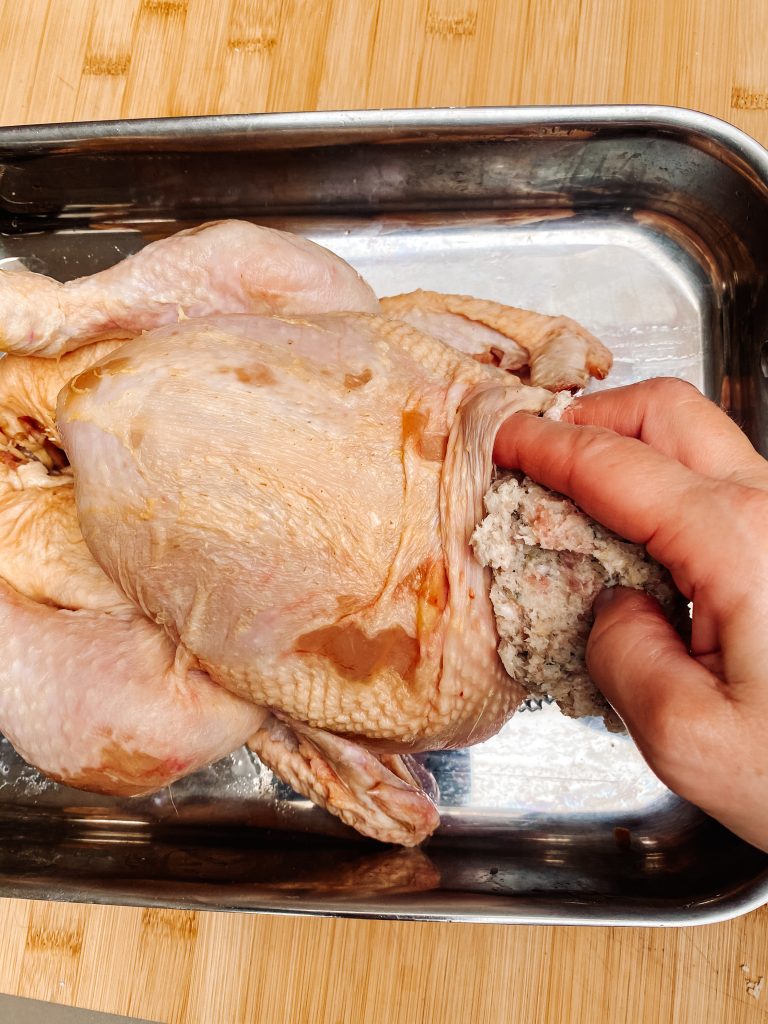
2 Stuff this area with 1/3 of the stuffing. 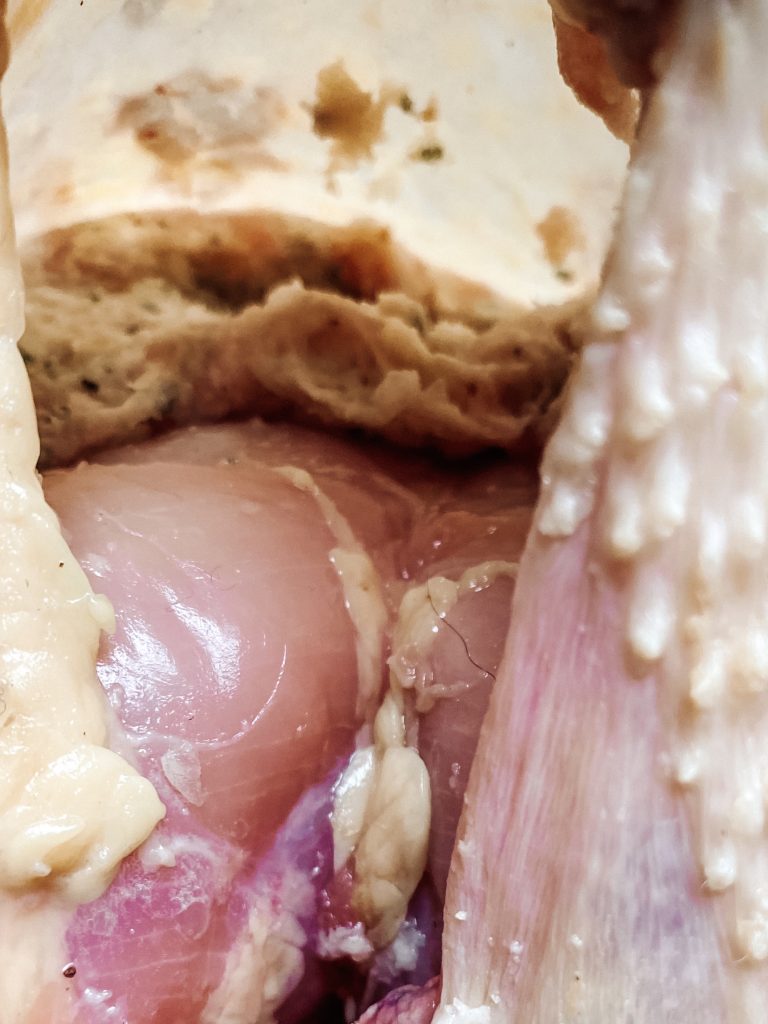
You will get a lovely flavourful area between the skin and the meat 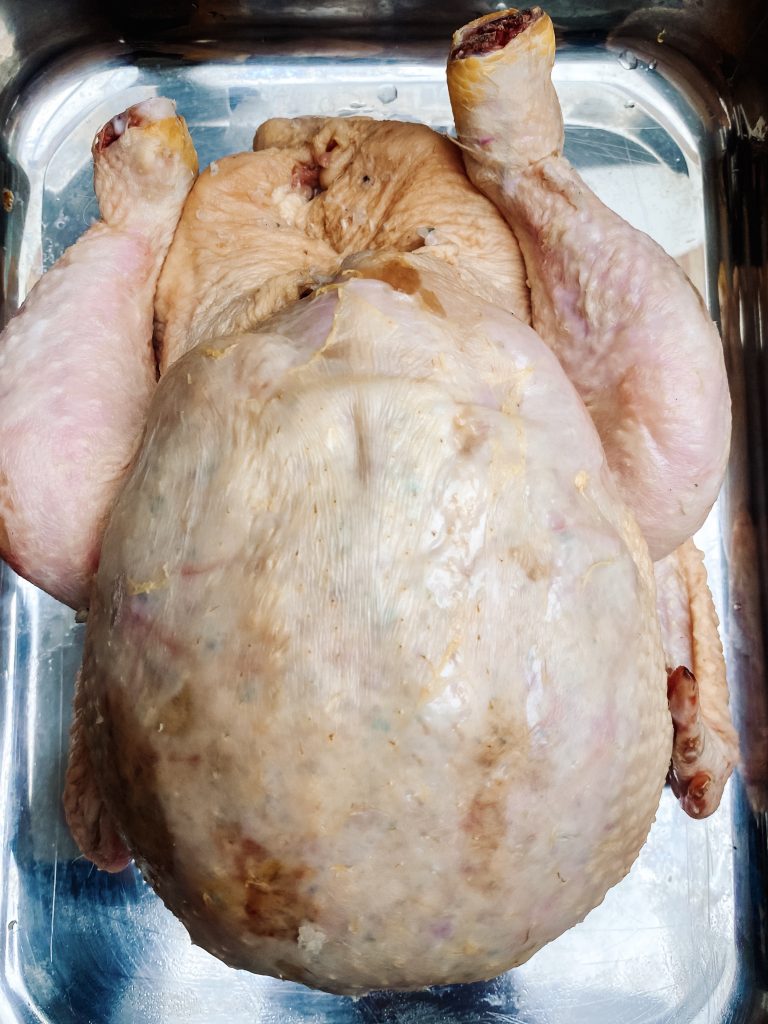
3 Use your hands to pat the stuffing into a neat shape and ensure it is the same thickness over the breast. 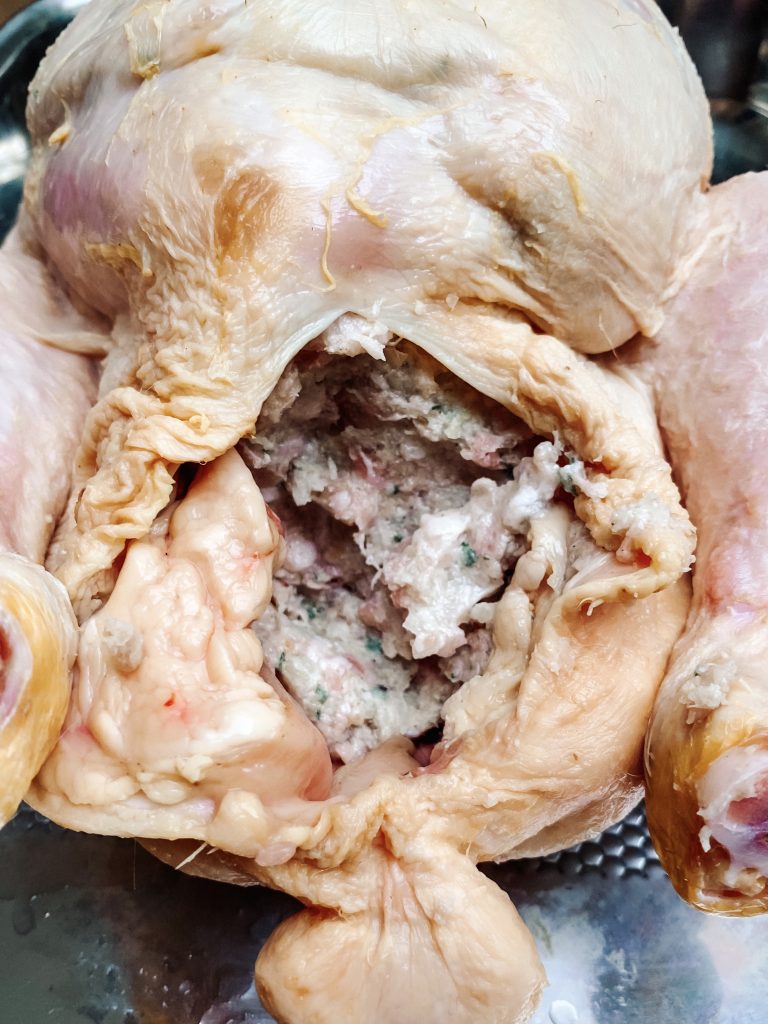
4 Put the remaining stuffing inside the cavity of the chicken
Not a fan of stuffing?
If you would rather not use stuffing, try adding some seasoned butter and chopped fresh herbs in the layer between the skin and the breast meat. Simply separate the skin and the meat as shown above and smear the butter over the breast and under the skin. Make sure your butter is at room temperature, season with salt and freshly ground black pepper and chopped herbs to taste. You could use sage, tarragon, parsley, rosemary, thyme, chives, dill, whatever takes your fancy. You could even throw in a little crushed garlic.
Oil and Season the Chicken:
- Use your hands to rub the olive oil all over your chicken making sure you oil the underside of the bird and get into all the creases and nooks and crannies.
- At the same time make sure the flaps of skin are pulled over the stuffing in the cavity of the chicken.
- Also ensure the skin covers and is pulled around the stuffing between the skin and the breast meat.
- Grind over a generous portion of sea salt and black pepper.
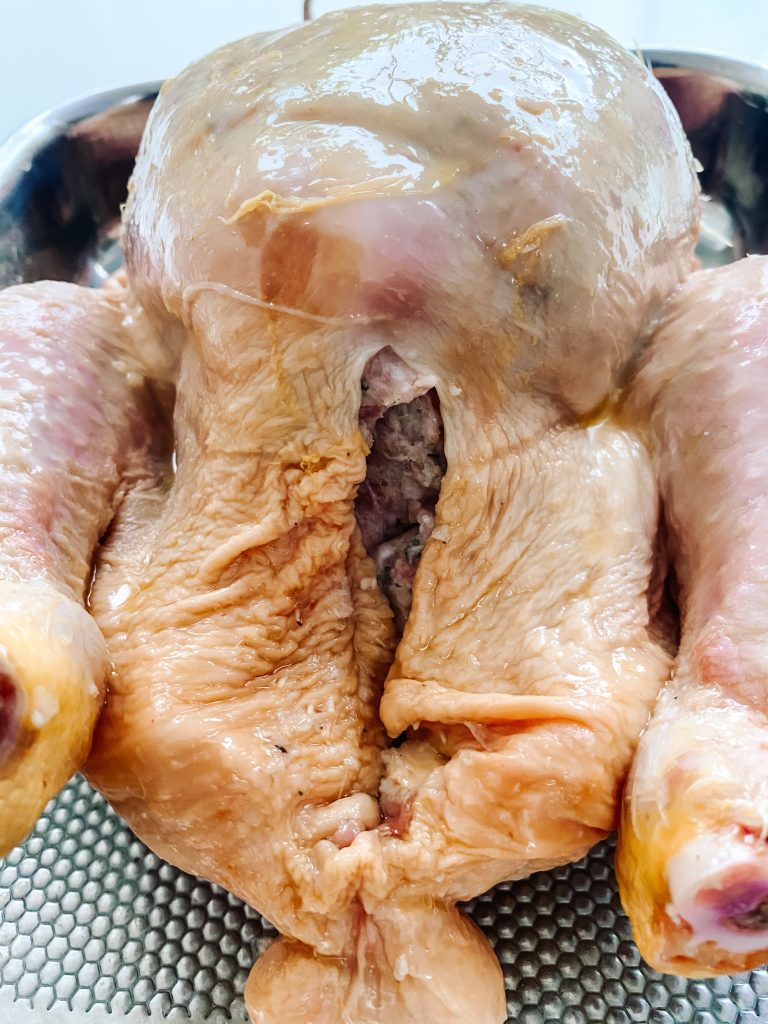
1 and 2 – Rub oil on the chicken. Ensure skin covers the cavity 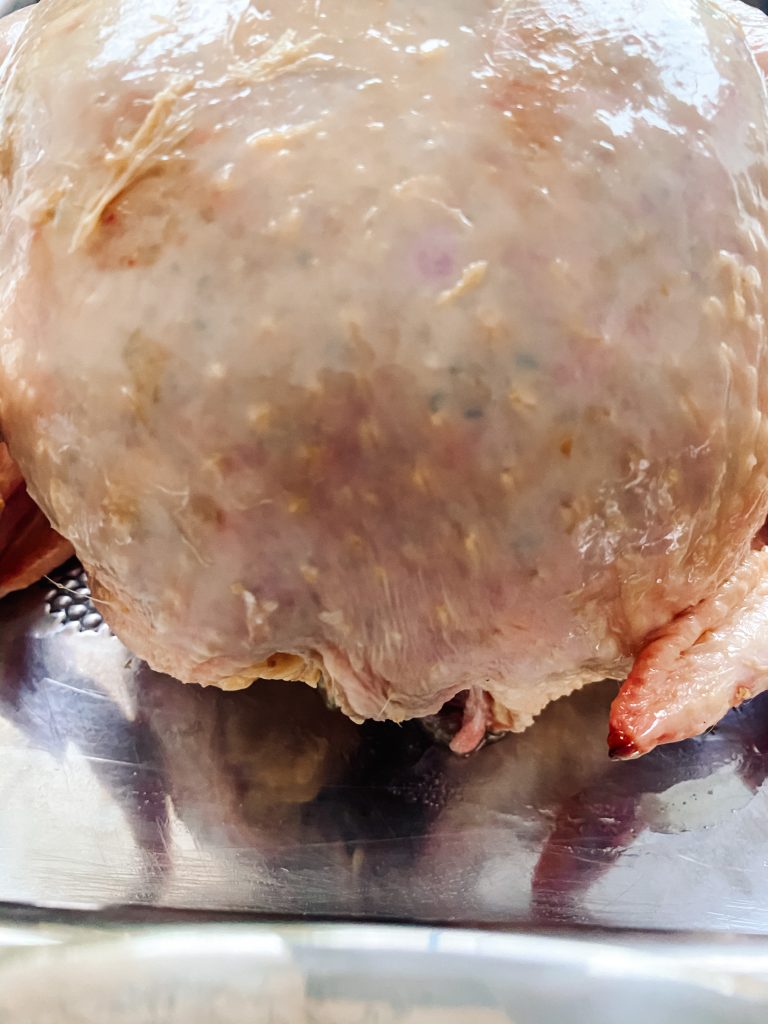
3 Ensure skin covers the stuffing and breast meat 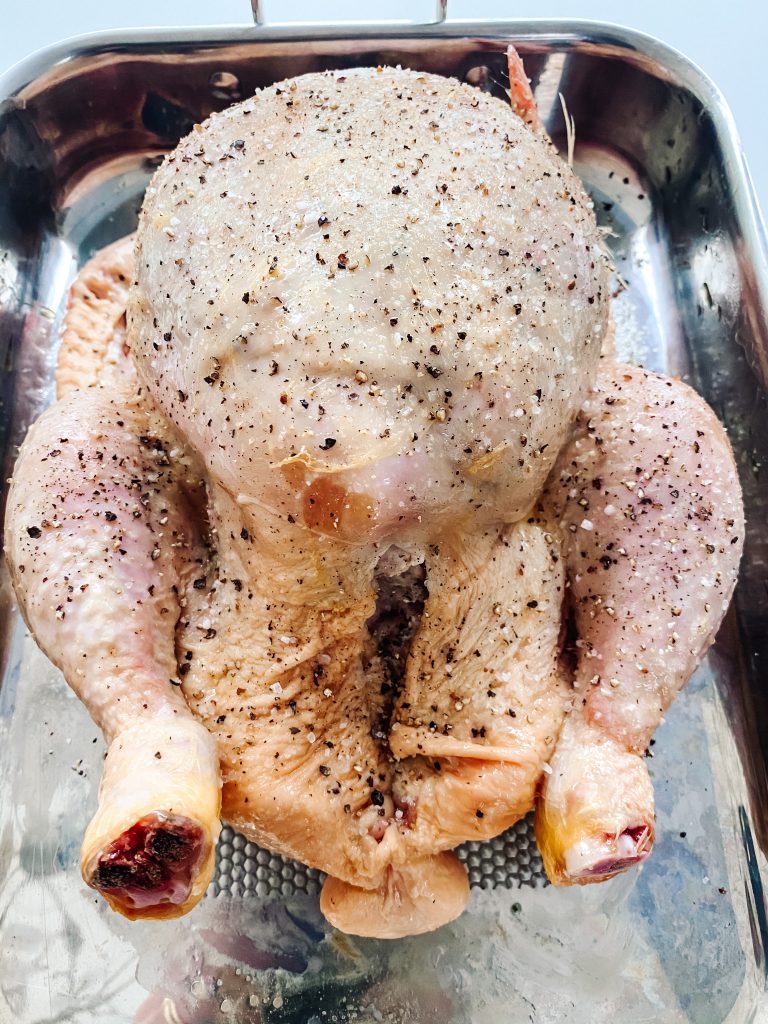
4 Grind over fresh sea salt and black pepper
Roast the chicken:
When calculating cooking times, it is important you make sure you:
- allow time for the chicken to come to room temperature before cooking. This can take 30 minutes to an hour, depending on the size of the chicken and the ambient room temperature.
- also allow time for resting the chicken after it has been cooked. I usually rest a chicken for around 15 minutes.
Why should meat be cooked at room temperature?
When you cook any meat, the muscles will contract and tighten when heated. The colder the muscles the more they will contact and this means it is harder for the heat to distribute evenly when cooking. By letting the meat come to room temperature before you cook it, your meat will cook more evenly and you will end up with juicier meat. It can take between 30 – 60 minutes for your fridge cold meat to reach room temperature depending on its size and the room temperature.
You also need time to rest the meat after cooking:
As the muscles of the meat contract and tighten when cooked, the juices are forced toward the surface of the meat and some will evaporate. (Which is why overcooked meat is dry.) Allowing the meat to rest after you have removed the heat source, means the muscles will relax and the juices can re-distribute throughout the meat. If you cut it immediately, you are in danger of losing some of these juices and your chicken may be dry and also lose the flavour from those gorgeous juices.
How long should you cook the chicken for?
The length of time a chicken takes to cook will depend on both its size and also the temperature of the oven. When calculating the weight of the chicken, it is very important to add the weight of the Sage, Onion and Sausagemeat Stuffing as well. The stuffing recipe given here weighs approximately 700g, depending on the size of the onion you use.
- Preheat oven to Fan Oven 180°C/200°C/400°F/Gas 6
- Cover the chicken and stuffing with foil and cook for 20 minutes.
- Turn the oven down to Fan Oven 160°C/180°C/350°F/Gas 4
- Continue to cook for 30 minutes per kg.
- (For those working in imperial measures, 1 kg is 2.2lbs and 100g is 3.5oz)
- 30 minutes before the end of cooking time, remove the foil and continue to cook so the skin browns and becomes crispy.
The chicken in the photographs was 2.3kg and the stuffing was 700g which comes to 3kg in total. So I:
- cooked the chicken with the foil on for 20 minutes at the higher temperature.
- continued to cook at the lower temperature for 1 hour.
- I then removed the foil and continued to cook for a further 30 minutes.
- Total cook time therefore was 1 hour and 50 minutes.
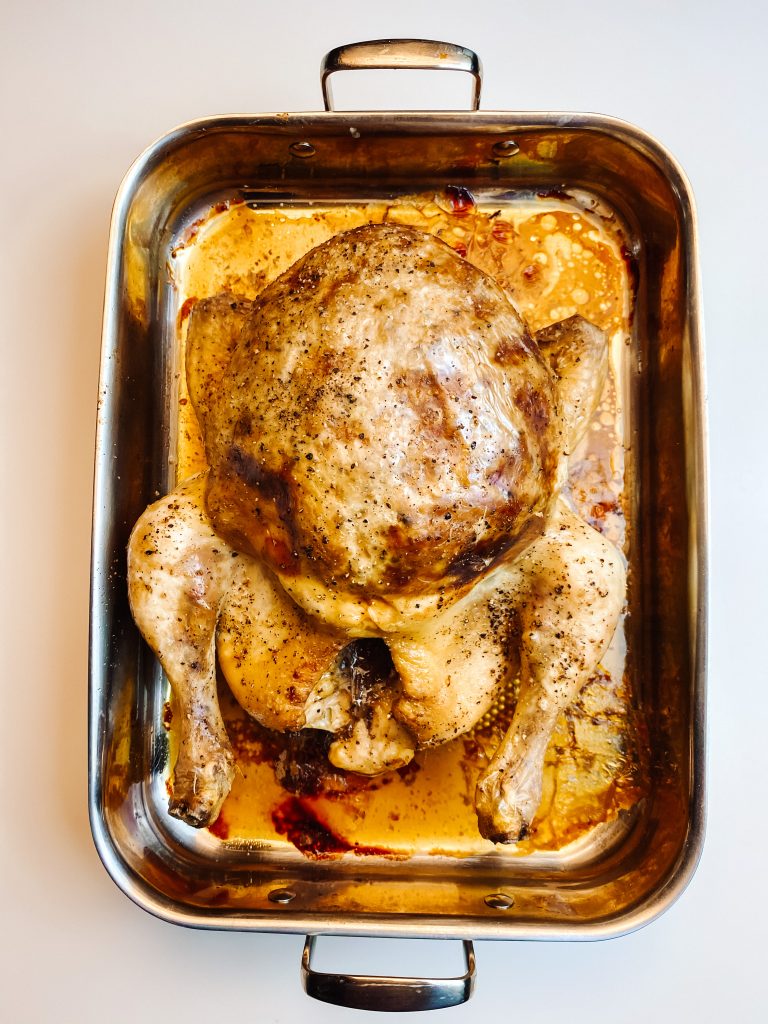
The chicken is now cooked 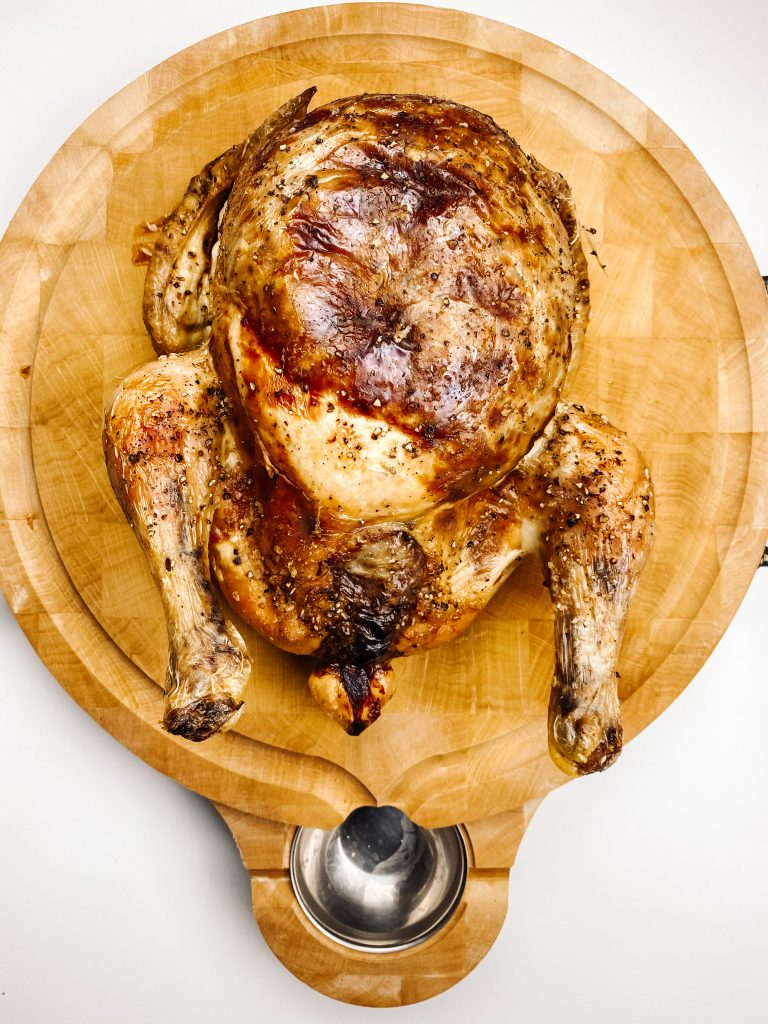
Transfer to a chopping board to rest 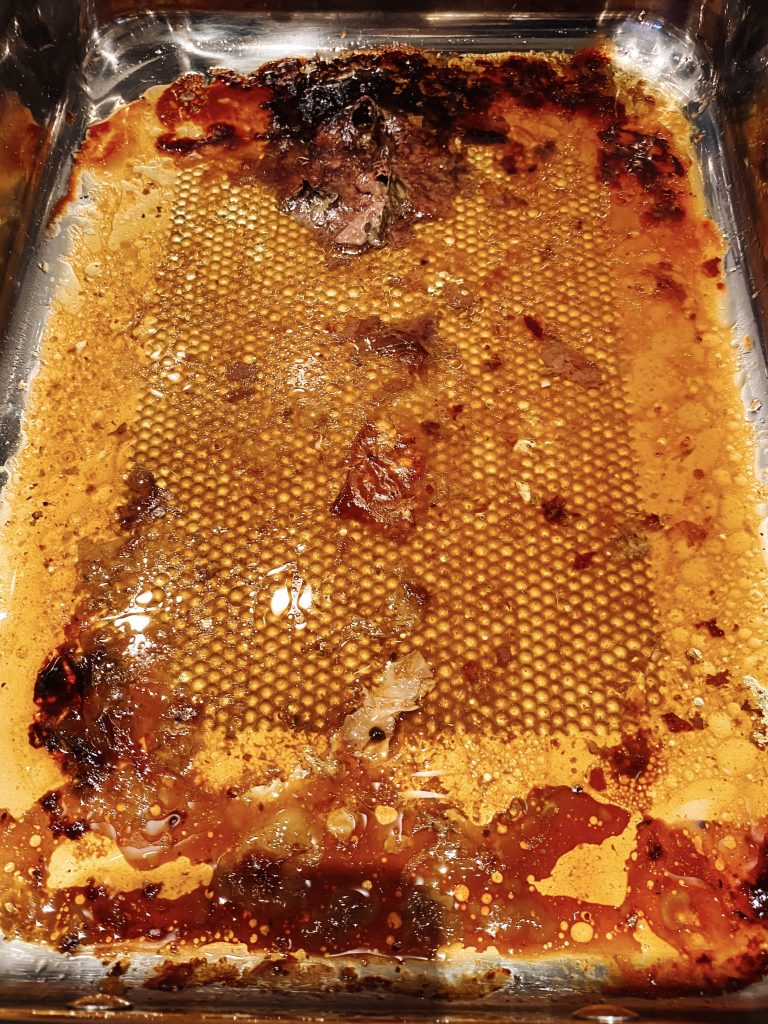
Keep all these delicious juices for the gravy.
To check the chicken is cooked:
Pull the leg away from the bird slightly and skewer into breast flesh behind the leg. Any juices coming out of the bird should be clear and the meat should be opaque. If you see any pinkness or blood, cook for a further 10 – 15 minutes. If you use a meat thermometer, the internal temperature of the meat should read 165°F or 75°C.
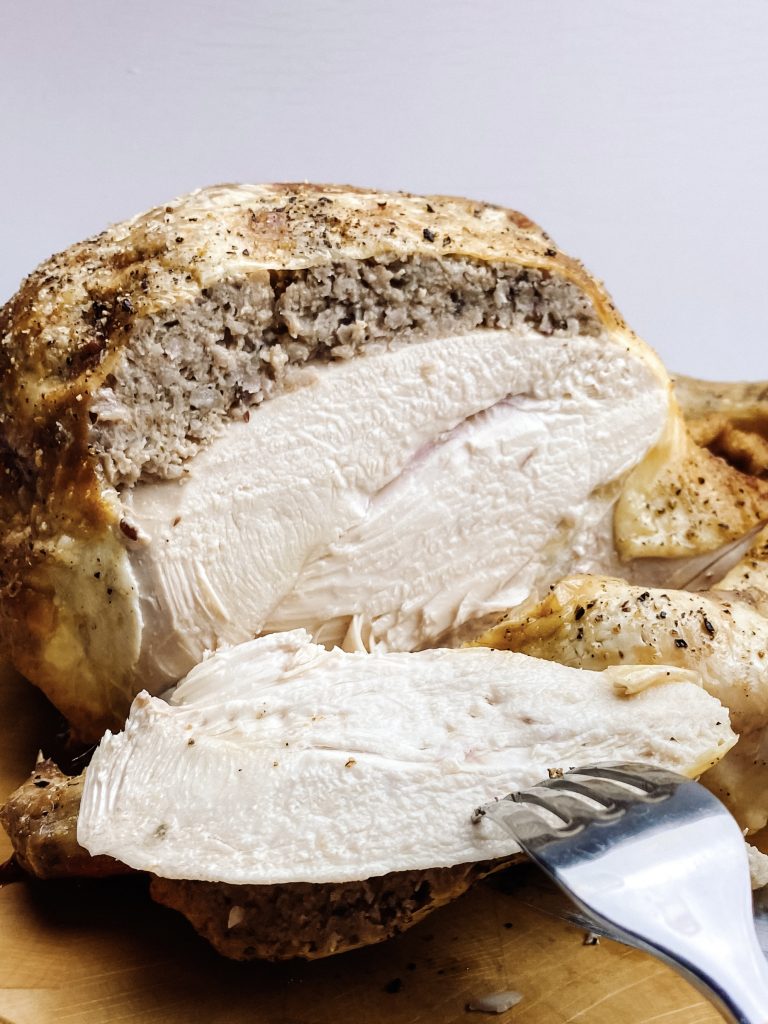
Make the Gravy:
- If you can remove any of the fat sitting on top of the delicious gubbins in the pan, do so. The amount you have will depend on the chicken and the sausages you use. You need some fat for the gravy so you do not need to be too precious about it.
- Add 4 tablespoons of plain/all-purpose flour to the pan and mix thoroughly. I use a small balloon whisk.
- Add the vegetable or potato water or stock and bring to a gentle simmer stirring all the time. (My favourite is using the potato water and if I need more, I use either the water from cooking other vegetables or some stock.) Cook for 4 – 5 minutes stirring regularly and scraping up all the gorgeous sticky bits from the base of the pan.
- Strain the gravy into a saucepan and cook until you achieve the consistency you seek. Some people like thick gravy and others a thinner sauce, go with whatever you like. If it is too thick, add some extra vegetable water.
- Taste and adjust the seasoning and transfer to a gravy boat for serving. (NB Do not season your gravy until you have tasted it – remember the chicken, sausagemeat and vegetable water have all been seasoned. You may even find it does not need any extra salt and pepper but always check.)
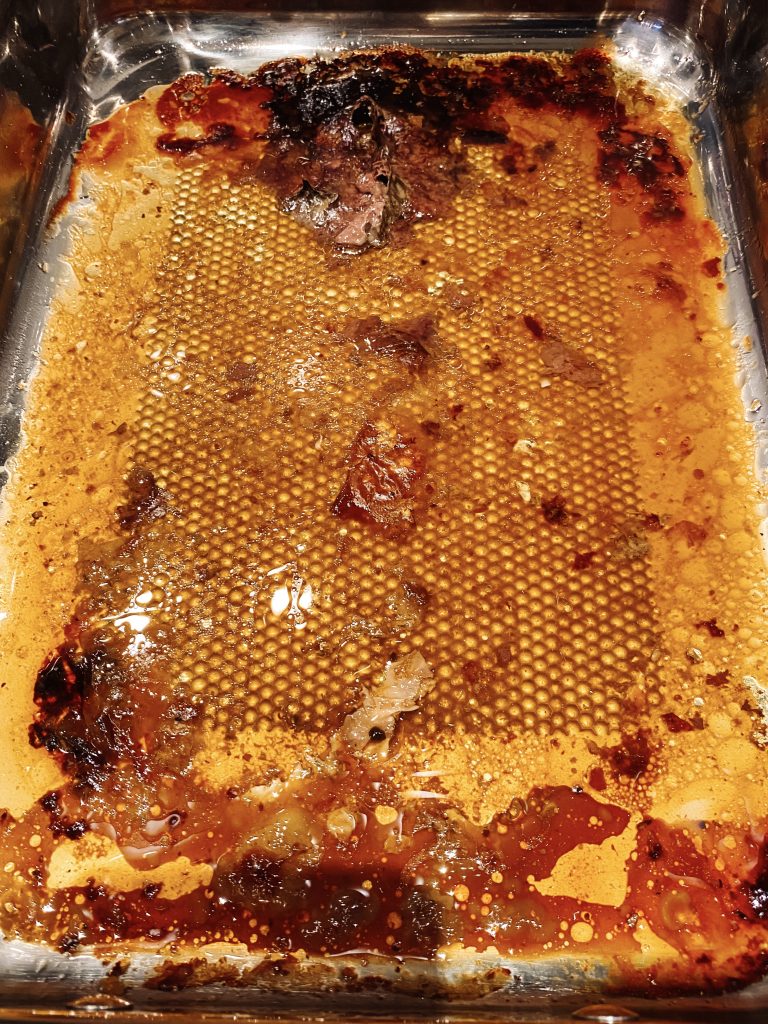
1 Remove any extra fat if possible 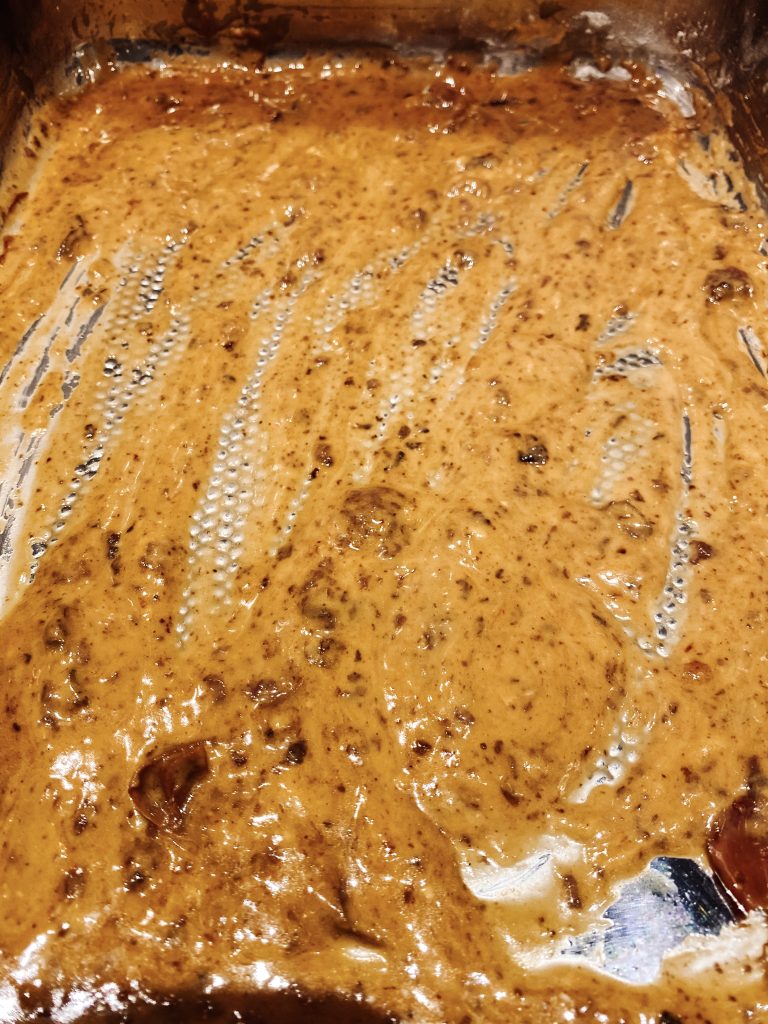
2 Add the flour and mix thoroughly 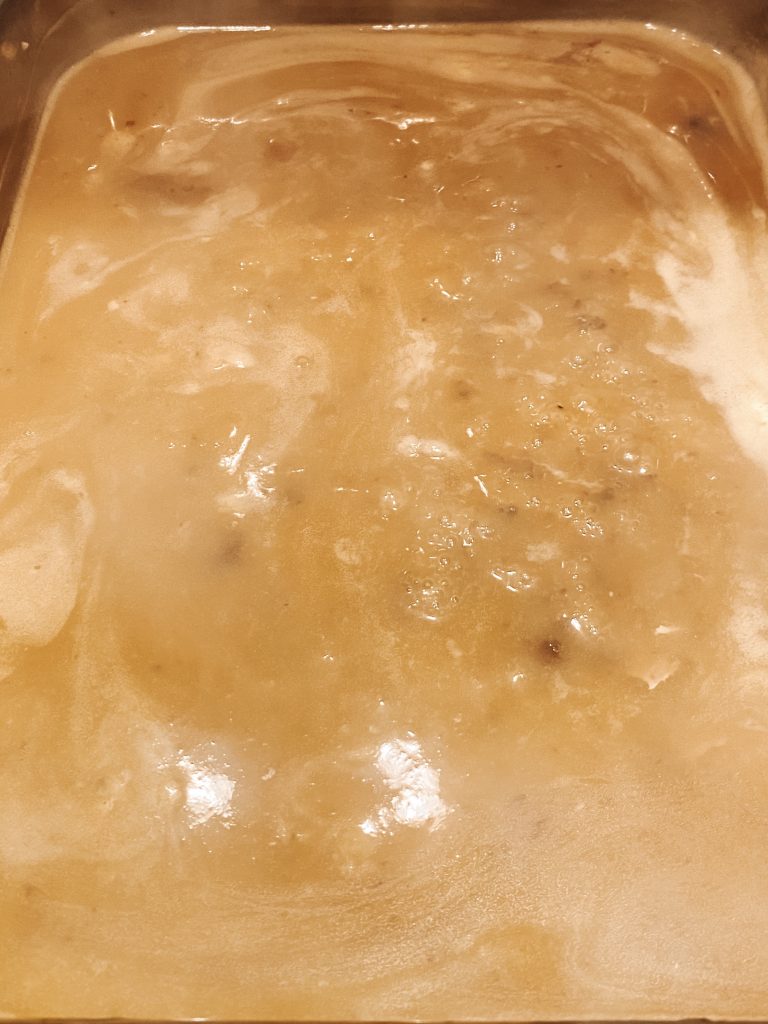
3 Add the potato water and cook for 4 – 5 minutes 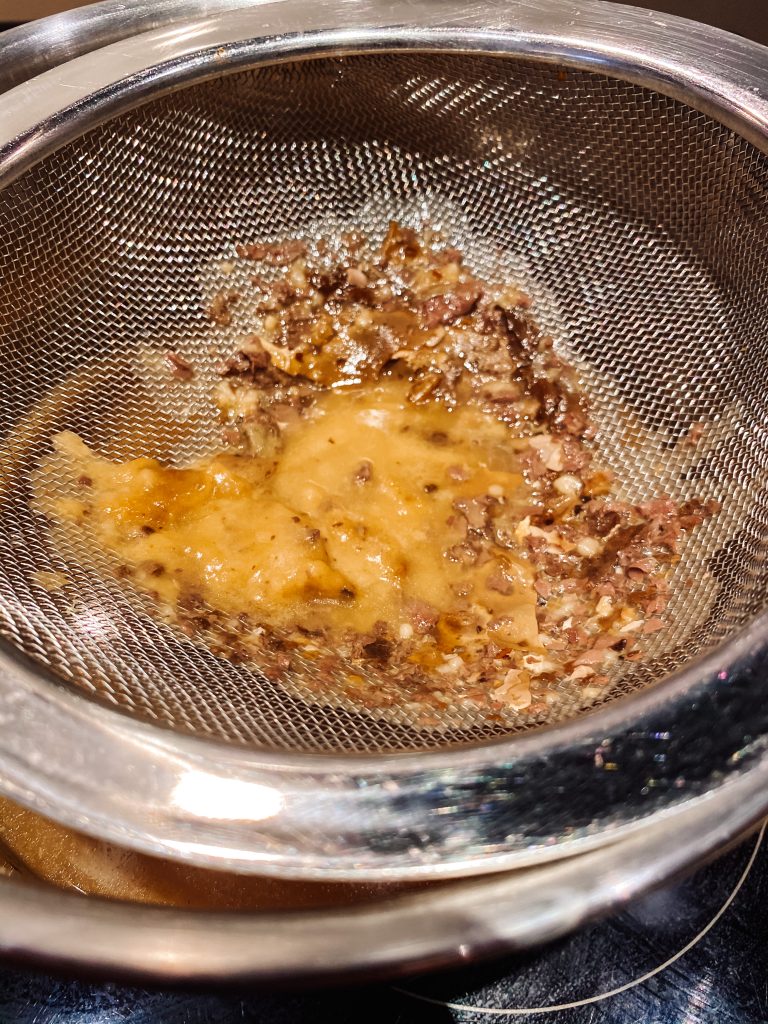
4 Strain the gravy into a saucepan 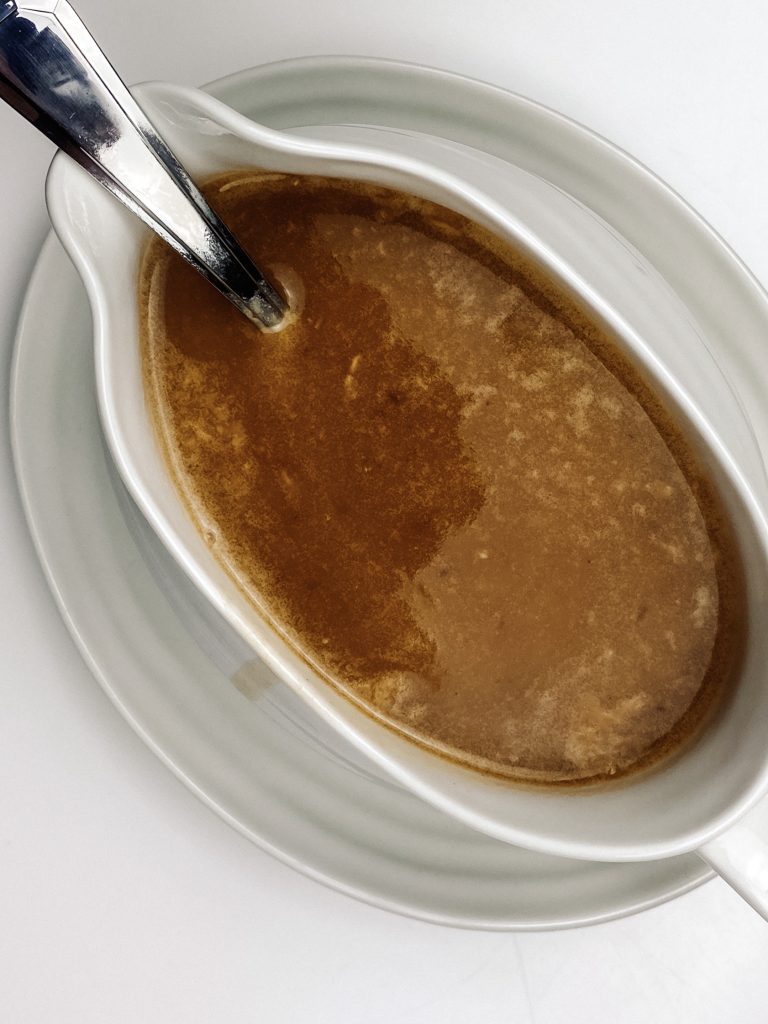
5 Reheat and reduce slightly until you get the thickness you seek.
Carve and Serve your Roast Chicken:
Just look at that delicious layer of stuffing on top of the breast meat. Yum, yum, yum. (NB the pink is where Andrew cut through bone and not under-cooked meat!)
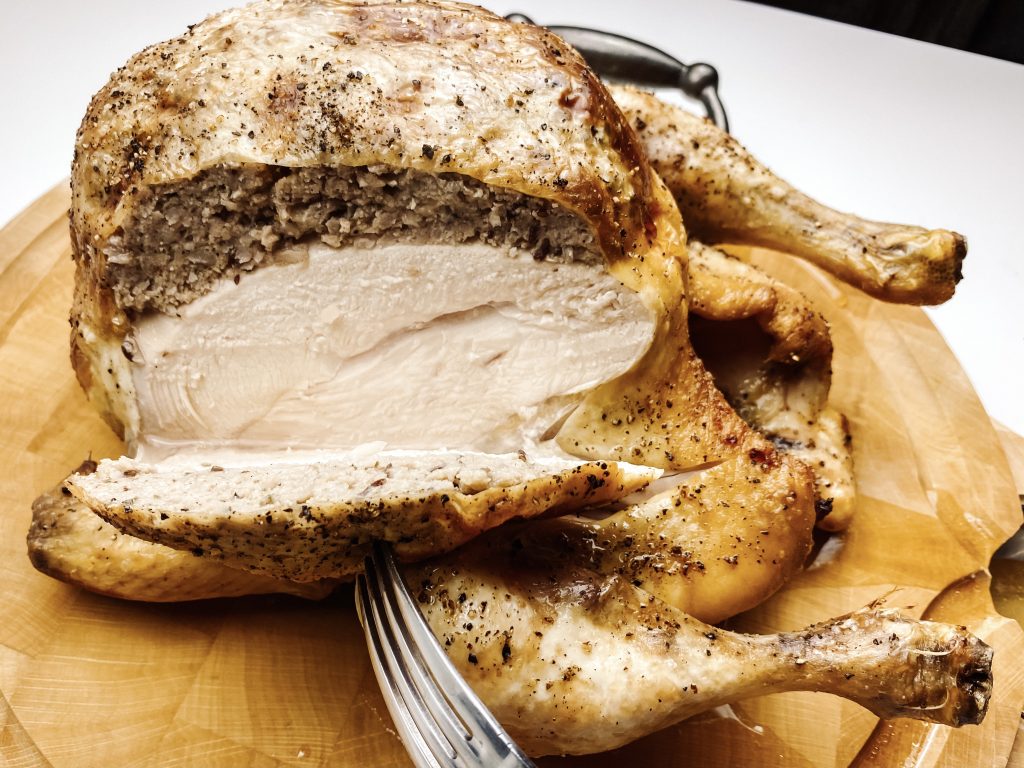
Look at that delicious layer of stuffing on top of the breast meat.
Serve with:
Potatoes and vegetables which you have roasted alongside the chicken and an amazing bottle of Californian Ramey Chardonnay from the Russian River Valley!
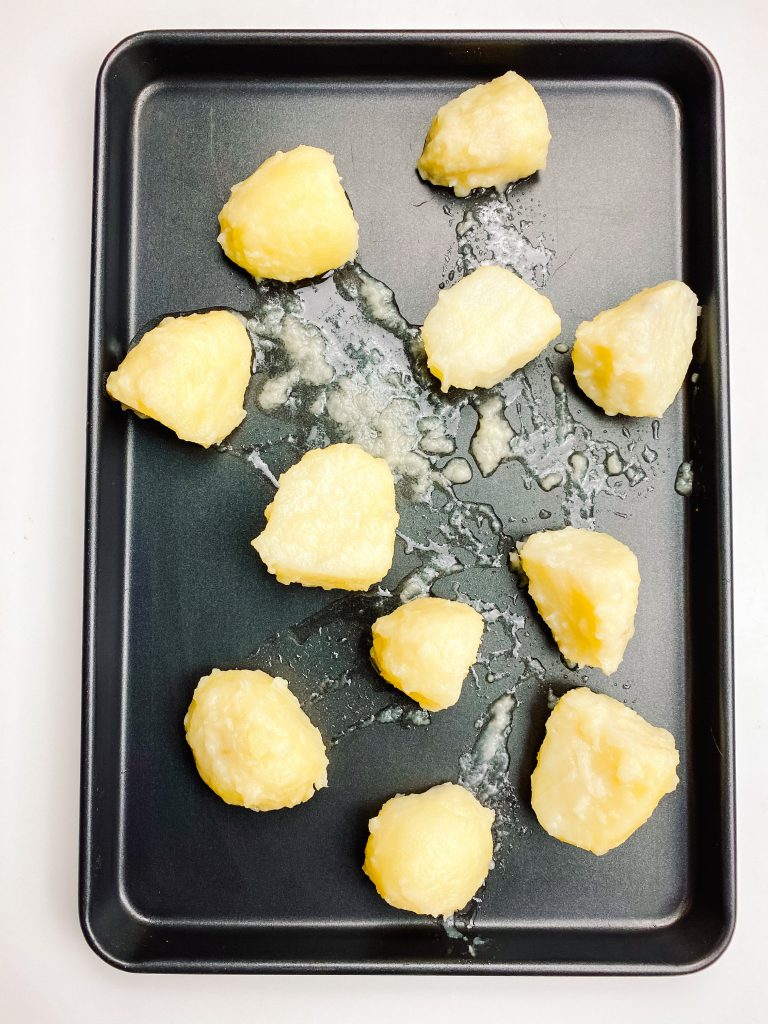
Potatoes to be roasted 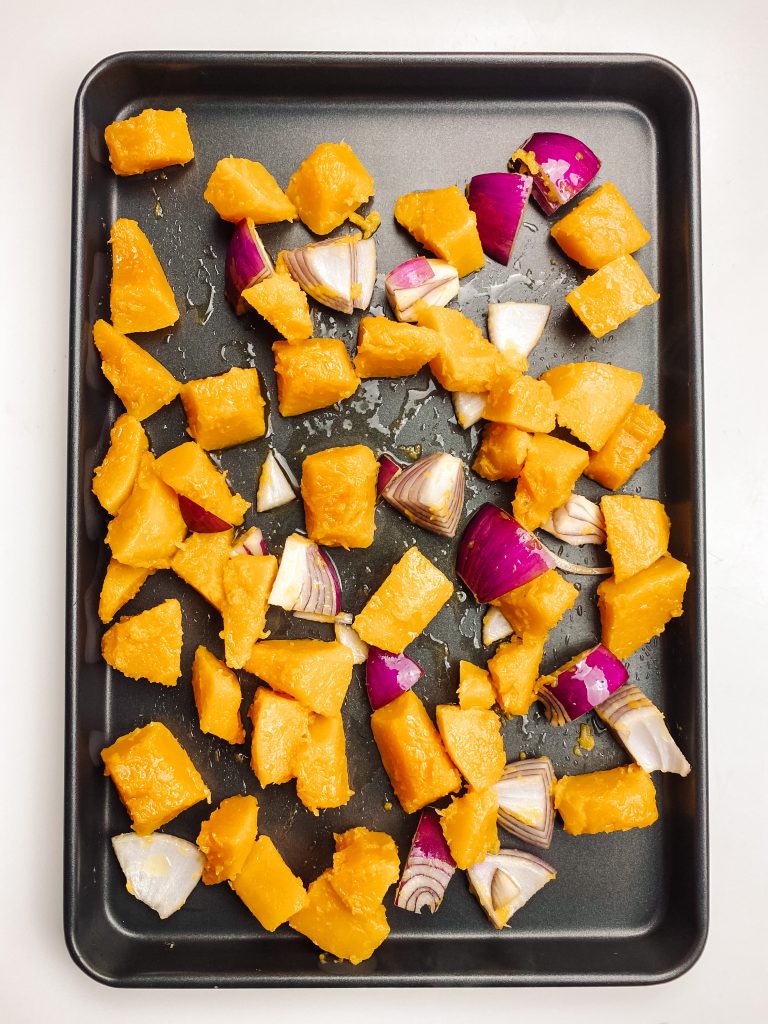
Butternut squash and red onion to be roasted 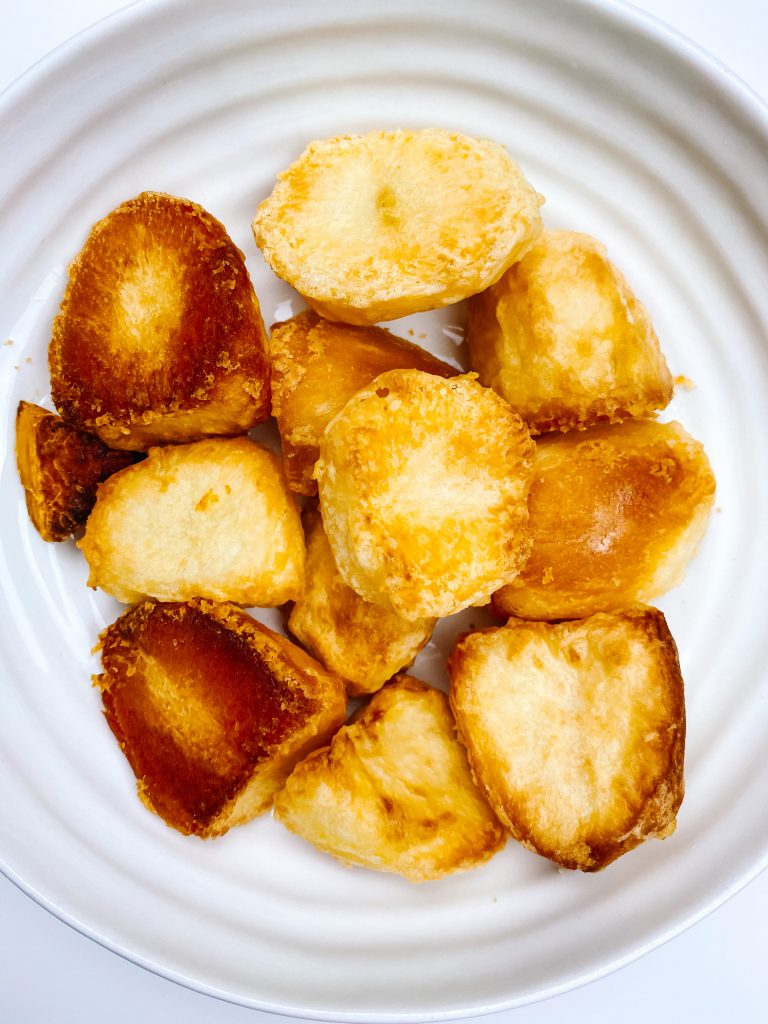
Roast potatoes 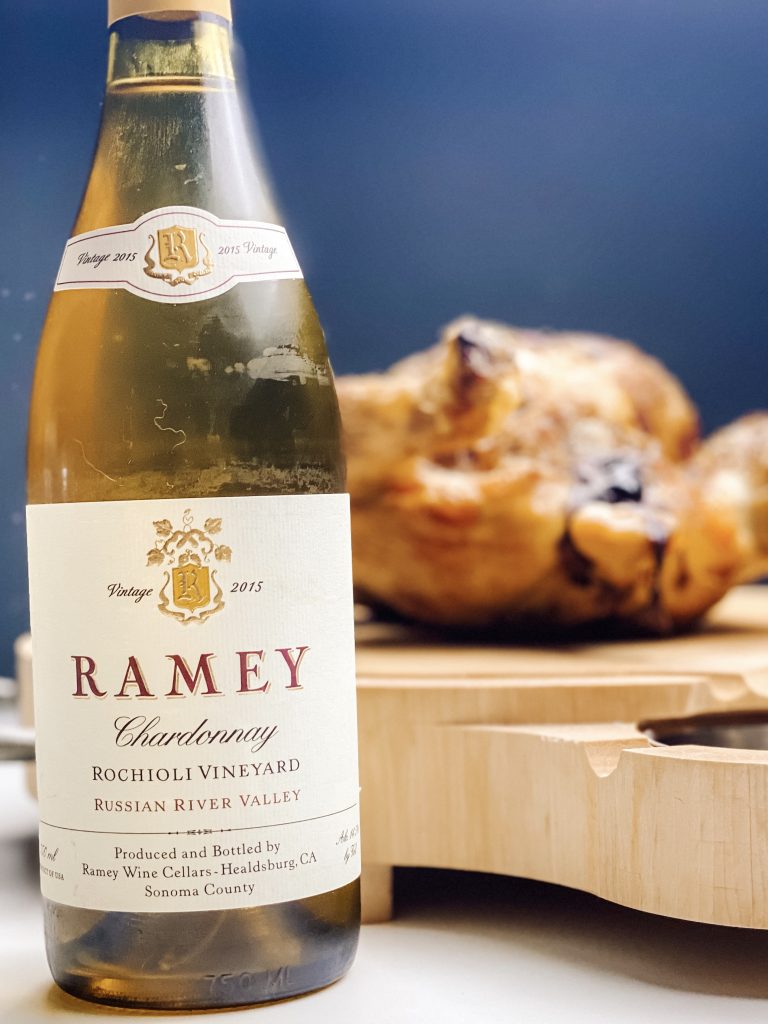
Amazing Californian Chardonnay 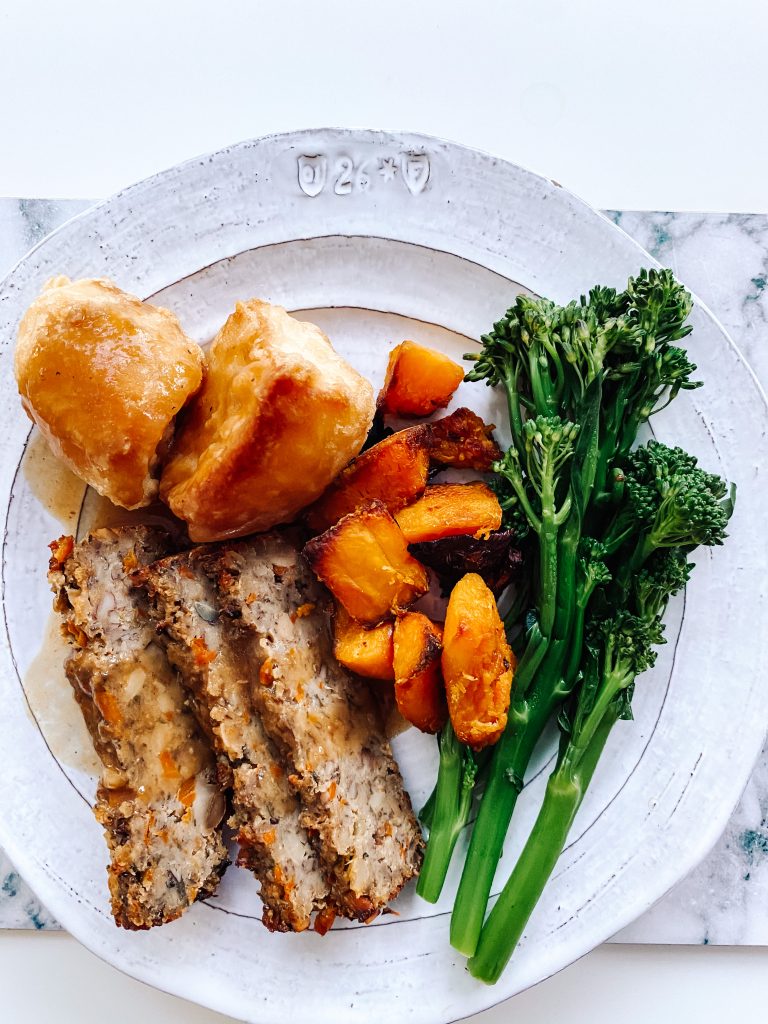
Roasts and green vegetables with Emma’s nut roast which she ate when we ate the chicken!
Made this recipe?
If you make this recipe, do please tag me on instagram @daffodilkitchen. You could also leave a comment in the box directly below the recipe.
How I Roast Chicken for a Roast Chicken Dinner
Succulent and tender chicken meat cooked with and surrounded by a delicious layer of sage, onion and sausagemeat stuffing.
Ingredients
For the Roast Chicken:
- 1 quantity of Sage and Onion Sausagemeat Stuffing
- 1 whole chicken, roughly 2 – 2.5kg in weight
- 2 tablespoons olive oil
- ½ teaspoon freshly ground sea salt
- good grinding of freshly ground black pepper
For the gravy:
- 4 tablespoons plain/all-purpose flour
- 1 litre of potato or vegetable water or chicken stock (See Recipe Notes)
- salt and freshly ground black pepper – optional
Instructions
-
Take the chicken out of the fridge roughly 30 – 45 minutes before you want to cook it – it is always best to start cooking chicken when it is at room temperature rather than straight from the fridge.
-
Collect together your equipment (see Recipe Notes below) and ingredients.
-
Stuff the chicken: make your sausagemeat stuffing if necessary
-
Put a layer of stuffing between the skin of the chicken and the breast meat. To do this, use your hand to gently ease the skin from the meat and make space for the stuffing.
-
Stuff the area between the skin and the breast meat with around ⅓ of the stuffing. Gently ease it into the space using your hand, being careful not to rip the skin
-
Use your hands to pat the stuffing into a neat shape and to ensure it is roughly the same thickness over the breast.
-
Put the remaining stuffing inside the cavity of the chicken
-
Oil and Season the Chicken: use your hands to rub the olive oil all over your chicken making sure you oil the underside of the bird and get into all the creases and nooks and crannies.
-
At the same time make sure the flaps of skin are pulled over the stuffing in the cavity of the chicken and ensure the skin covers and is pulled around the stuffing between the skin and the breast meat.
-
Grind over a generous portion of sea salt and black pepper.
-
Roast the chicken: calculate the cooking times (see below) and preheat oven to Fan Oven 180°C/200°C/400°F/Gas 6
-
Cover the chicken and stuffing with foil and cook for 20 minutes.
-
Turn the oven down to Fan Oven 160°C/180°C/350°F/Gas 4
-
Continue to cook for 30 minutes per kg.
-
30 minutes before the end of cooking time, remove the foil and continue to cook so the skin browns and becomes crispy.
-
When the chicken is cooked, remove from the oven, transfer to a chopping board and rest for 15 minutes before you carve and serve. If you want crispy skin, do not cover with foil or the chicken will sweat and the skin will lose its crispiness. It will still be quite warm so don't worry about not covering.
-
Make the Gravy: if you can remove any of the fat sitting on top of the delicious gubbins in the pan, do so. You need some fat for the gravy so you do not need to be too precious about it.
-
Add the flour to the pan and mix thoroughly. I use a small balloon whisk.
-
Add the vegetable or potato water or stock and bring to a gentle simmer stirring all the time. Cook for 4 – 5 minutes stirring regularly and scraping up all the sticky bits from the base of the pan.
-
Strain the gravy into a saucepan and cook until you achieve the consistency you seek. Some people like thick gravy and others a thinner sauce, go with whatever you like. If it is too thick, add some extra vegetable water.
-
Taste and adjust the seasoning, if necessary. Transfer to a gravy boat for serving.
-
Carve and Serve your Roast Chicken: I like to serve roast chicken with roast potatoes and vegetables which you have roasted alongside the chicken, some green vegetables and also some creamy, dreamy mashed potatoes. Don't judge, but I also love some apple sauce on the side!
Recipe Notes
Equipment for the stuffing, if necessary:
- food processor
- kitchen scales and measuring spoons
- chopping board and knife
Equipment for the roast chicken and gravy:
- roasting tin
- carving board and carving knife and fork
- saucepan and sieve or strainer
- gravy boat
How long should you cook the chicken for?
The length of time a chicken takes to cook will depend on both its size and also the temperature of the oven. When calculating the weight of the chicken, it is very important to add the weight of the Sage and Onion Sausagemeat Stuffing as well. The stuffing recipe given here weighs approximately 700g, depending on the size of the onion you use.
- Preheat oven to Fan Oven 180°C/200°C/400°F/Gas 6
- Cover the chicken and stuffing with foil and cook for 20 minutes.
- Turn the oven down to Fan Oven 160°C/180°C/350°F/Gas 4
- Continue to cook for 30 minutes per kg.
- (For those working in imperial measures, 1 kg is 2.2lbs and 100g is 3.5oz)
- 30 minutes before the end of cooking time, remove the foil and continue to cook so the skin browns and becomes crispy.
The chicken in the photographs was 2.3kg and the stuffing was 700g which comes to 3kg in total. So I:
- cooked the chicken with the foil on for 20 minutes at the higher temperature.
- continued to cook at the lower temperature for 1 hour.
- I then removed the foil and continued to cook for a further 30 minutes.
- Total cook time therefore was 1 hour and 50 minutes.
To check the chicken is cooked:
Pull the leg away from the bird slightly and skewer into breast flesh behind the leg. Any juices coming out of the bird should be clear and the meat should be opaque. If you see any pinkness or blood, cook for a further 10 – 15 minutes. If you use a meat thermometer, the internal temperature of the meat should read 165°F or 75°C.
Quantity of stuffing:
I use this amount of stuffing to stuff a 2 – 2.5kg chicken. We really like a lot of stuffing! If you use smaller chicken e.g 1.4kg – 1.5kg. I use half this amount of stuffing. I make the full amount and, as it freezes well, I then freeze half for another occasion.
Gravy – potato water, vegetable water or stock?
I use the potato water in the first instance and if I need more, I use either the water from cooking other vegetables or some stock.

Sage and Onion Sausagemeat Stuffing
You May Also Like
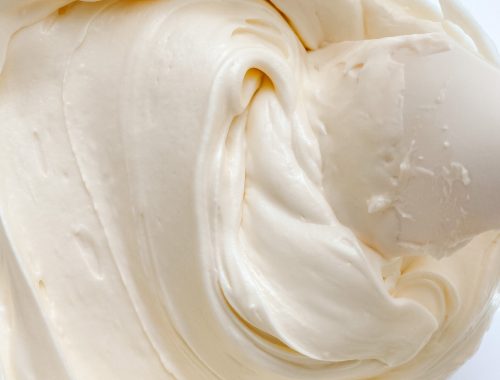
Cream Cheese Frosting
18th September 2020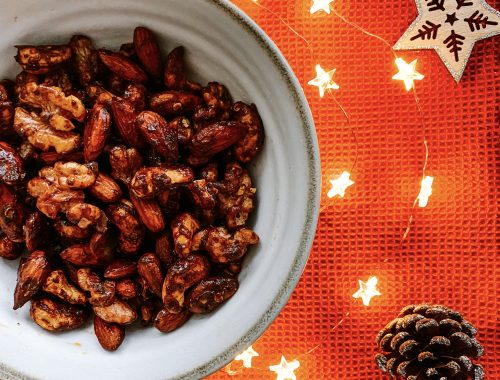
Sweet and Spicy Roast Nuts
16th December 2020